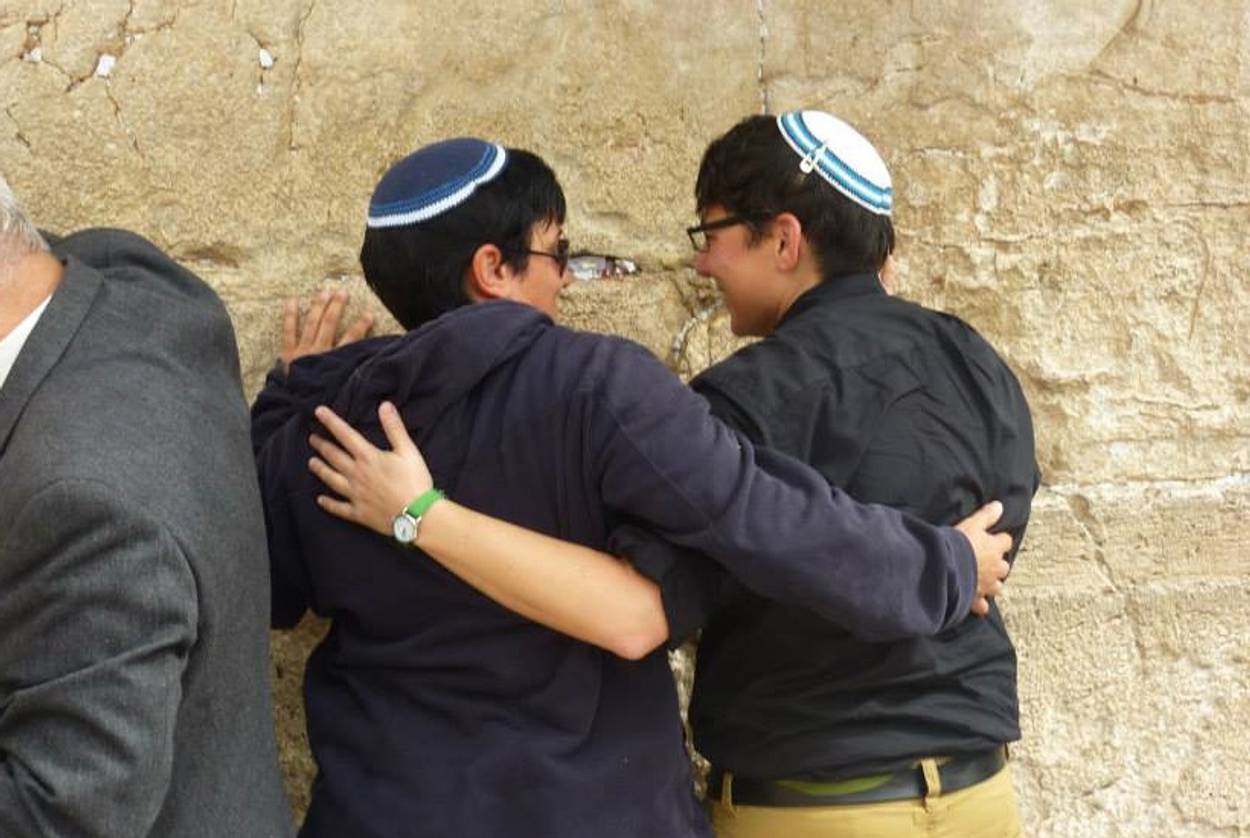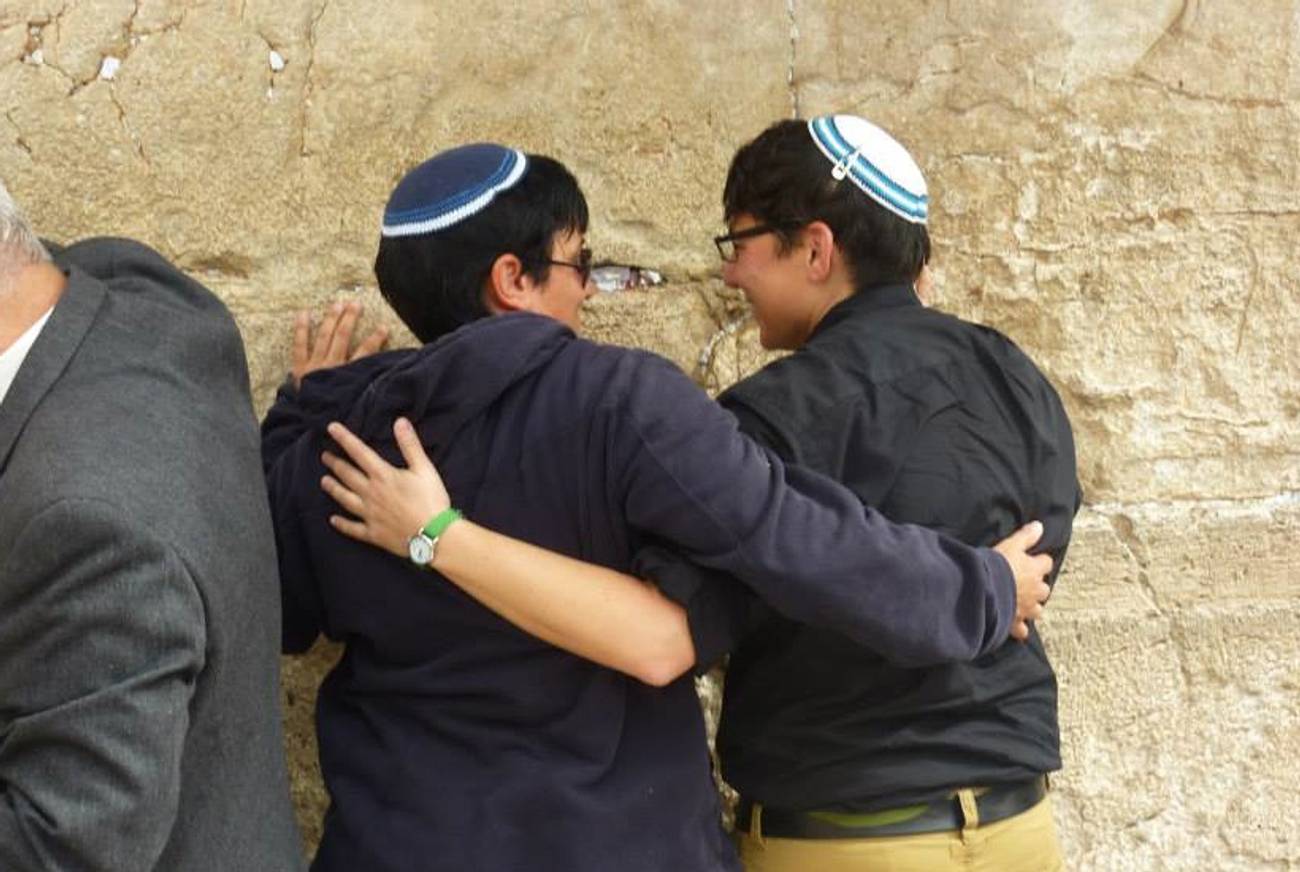For Transgender Jews, a Visit to the Western Wall Holds Unique Symbolism
Praying on the side with their chosen gender is a quiet political statement for some, and a personal milestone for others




Transgender activist Surat Knan, who is currently transitioning from a female to male identity, visited Jerusalem’s Western Wall last November to pray on the men’s side. “I was very nervous, but elated,” said the London-based founder of the LGBT group Rainbow Jews, who was prepared for a fight.
“You hear a lot of stories about ultra-religious people who can get very aggressive when it comes to these things,” Knan added, referring to protests such as those against Women of the Wall, a group campaigning for the rights of women praying at the Kotel. “Would they kick me out, call the police, throw stones, spit at me?”
Knowing the visit would be as much a political action as a religious pilgrimage, Knan decided to document it on video. But the anxiously awaited fight never came. “It was obvious people on the male side didn’t realize that I was a non-cis male, but that’s not the point,” Knan told me. “The achievement of the action was to raise awareness and open a discussion, which shouldn’t stop with: Can you pass as a woman or as a man?”
As Knan explains in the video: “I want to show that gender separation ‘by biology’ doesn’t make any sense.”
Knan visited as part of a trip with A Wider Bridge, a California-based group that builds links between the Jewish LGBT community in Israel and the Diaspora. The 23 participants from the United States and Britain included five female-to-male transgender people as well as those, like Knan, who describe themselves as gender-queer—an umbrella term for people who don’t feel their gender identity fits in with the norms associated with their biological sex. There were no slogans, placards, or overt demonstrations during the visit, but nonetheless, “it was a very meaningful moment,” said A Wider Bridge’s Executive Director Arthur Slepian, who accompanied the group. “The Kotel is very binary, but all the trans people got to pray at the side of the wall they wanted to.”
For Knan, the point of the action was to document a momentous, personal event while simultaneously making a quietly political statement: that gender segregation is merely a matter of perception and interpretation: “You should be able to pray where your soul wants to be. I respect halakha, but I don’t intrude on others and tell them what to do, and so I don’t want to be told either. If there are separate sections [for men and women], I want to be on the side where I am drawn to spiritually.”
As Knan says in the video, while standing on the men’s side, touching the wall: “This is actually where I belong.”
***
Women of the Wall has drawn much media attention with its struggle for female prayer services to be held at the Kotel with women permitted to pray out loud and wear kippot and tefillin, currently banned by local regulations.
But a small group of transgender and gender-queer Jews are fighting a different, less publicized battle at the Wall. The Western Wall Heritage Foundation, the body overseeing the site, did not respond to requests for comment on its policy regarding transgender visitors, but some transgender activists believe the authorities are either wary of confronting the issue or ignorant of its existence.
“I don’t look like the butchest thing around, I get ‘ma’amed’ on the phone all the time,” said Melvin Marsh, 32, a transgender student from Georgia who was on the same trip as Knan. But, as with Knan, Marsh encountered no problems while he prayed on the men’s side of the Kotel in November. In fact, he recalled being high-fived by a Chabad emissary who asked if he wanted to put on tefillin before praying. Marsh was able to assure him that he’d already done so that morning.
And, Marsh noted, “all the trans people who definitely look female—because they haven’t transitioned yet—davened in the men’s section.”
The likelihood that the Orthodox Jews worshipping alongside the group were oblivious to the fact they were sharing sacred space with transgender people does not detract from the participants’ sense of achievement. “I feel my Kotel action was a victory—there was no need at this stage to produce a banner or placard,” explained Knan. “My action was a documentation, a piece of unstaged evidence: to enter a gender-segregated place in the physical body of the supposedly opposite sex without causing a stir. The action was to show that all the ‘aggro’ around sex segregation is unnecessary. Nothing happened. Nothing was supposed to happen. This was my point. Nobody was hurt.”
Indeed, many transgender people venturing to the Kotel are facing a personal rather than a public battle. Becky Silverstein, a rabbinical student from Boston, has blogged about his experiences at the Kotel. On his first visit, as a chaperone on an LGBT Birthright trip in 2011, Silverstein was asked to accompany a girl in the group to the women’s section. He went along, even though he was wearing long shorts, a polo shirt, and a kippa. “My guess is that it was tznius [modest] enough to get by,” he recalled, adding that while no one stopped him from entering the women’s side, “I felt like an impostor.”
During a subsequent extended stay in Israel, Silverstein returned to the Kotel, in a very different way. “I thought people were looking for gender markers, so I wore kippa and tzitzit, which put you firmly in that place,” he told me. “I walked down to the men’s side, my heart was pounding. I got close to the wall and said the fastest mincha ever, thinking at any moment someone is going to decide that I don’t belong here. From then on, I would go to the men’s side.”
“I have never experienced straight-up harassment at the Kotel—no one says you don’t belong here,” said Silverstein. But, he said, the discomfort “is more internal.”
Veteran Israeli transgender activist Nora Grinberg says she has known people who have been openly challenged by officials at the Wall, but that it nonetheless it is a uniquely symbolic place for transgender Jews. “It is a symbolic place and so sharply gendered it is very appealing to people who’ve just transitioned,” she explained. “The first time is extraordinarily important for a person who has just transitioned. It is a validation of your identity.”
For secular Jews like Knan, the Kotel has a historical symbolism, but for others like Marsh, who describes himself as “the most frum person in my synagogue,” praying at the Wall was of paramount importance.
In years of accompanying LGBT groups to Israel, noted Slepian, “no matter what stream of Judaism they belong to, one of the most profound experiences was at the Kotel.”
That’s something that American academic Joy Ladin, the first transgender professor at an Orthodox college, identifies with. In her memoir, Through the Door of Life: A Jewish Journey Between Genders, she documents two separate visits to the Kotel, “one for each side of the mechitza.”
The first was in spring 2002, years before her transition, when she went to the men’s side with her son while her then-wife went to the women’s section with their infant daughter. “I didn’t let myself hesitate to make these normative gender associations but it surprised me when it was so emotionally difficult. I felt terrible about it. It was excruciating,” Ladin recalled in a recent phone call.
The second visit, however, in 2008—nine months after “I had begun to live as myself,” Ladin said—“was an amazing experience,” when she visited the women’s side: “In early transition it’s just miraculous to walk around as yourself instead of pretending. I went back to the Wall, just me and my gender.”
But once there, she felt as if she risked violating the sacred space of the mostly ultra-Orthodox women in the female section. “Neither they nor the men would have wanted me on their side. I was going there as an expression of my Jewish identity, now I had to choose between respecting their sacred space or cutting myself off from the Jewish people.”
Ladin says she began weeping, overwhelmed with a sense of loss and pain. “Then I looked up and met the eyes of a Haredi woman. She was weeping, too. I felt we were the same gender—people with a broken heart. I didn’t end up feeling cut off, my gender was irrelevant. I had an authentic sense of community, that we had more in common as human beings than our differences.”
***
While transgender activists have started documenting their experiences, this has yet to become a full-fledged political issue the way Women of the Wall has. Shira Pruce, spokeswoman for WoW, stressed that her organization does not have an official position on the issue and would have to take a board vote to decide one. “In order to work together with all spectrums and politics, we only focus on our issue, the segregation of women in the public sphere,” she said, while emphasizing that they are LGBT-friendly and support “complete pluralism.”
For now, the Kotel seems to resonate most with transgender activists from outside Israel. Israeli transgender activists say they have more pressing battles with the country’s religious establishment: For instance, transgender people are excluded from marriage due to the Orthodox rabbinate’s refusal to recognize a change of gender, and they have to provide proof of surgery in order to change their status on their ID cards. “This is not the state’s business, and there is an international consensus that the state should not require proof of genital surgery to change someone’s legal gender,” said Grinberg.
“Transgender people are in a very powerless situation, and personally I don’t believe in these off-the-cuff acts of politics,” she continued. “The Kotel is not the issue. It’s Orthodox Judaism that’s very hostile to LGBT and trans people.”
Knan disagrees, arguing that gender segregation at the Kotel needs to be put to the test, and the fears of transgender people that they face bullying or harassment unless they “pass” must be addressed. The Wall has immense personal resonance for people who don’t conform to gender norms; but in the future, there is a public battle to be fought, too.
“Awareness work needs to be done,” Knan concluded. “Everyone, regardless of sex, gender, and physical appearance should feel welcome and safe in places of worship.”
***
Like this article? Sign up for our Daily Digest to get Tablet Magazine’s new content in your inbox each morning.
Daniella Peled is editor at the Institute For War and Peace Reporting and has reported widely from across the Middle East.
Daniella Peled is editor at the Institute For War and Peace Reporting and has reported widely from across the Middle East.